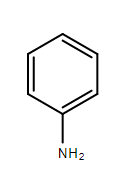
Why is Aniline Meta Directing?
Answer
487.2k+ views
Hint: Aniline is an organic compound with the formula $ {C_5}{H_5}N{H_2} $ . Consisting of a phenyl group attached to an amino group, aniline is the simplest aromatic amine. It ignites readily burning with a smoky flame characteristic of aromatic compounds. It has the odor of rotten fish.
Complete answer:

Aniline is considered as an electron-rich benzene derivative, and as a consequence, reacts rapidly in electrophilic aromatic substitution reactions. It is also prone to oxidation. Freshly purified aniline is an almost colorless oil, exposure to air results in gradual darkening of the sample (to yellow or red) due to formation of strongly colored, oxidized impurities.
Aniline is a slightly pyramidalized molecule, with the hybridization of the nitrogen somewhere between $ s{p^3} $ and $ s{p^2} $ . As a result, the nitrogen lone pair is in an $ s{p^x} $ hybrid orbital with high p character.
The aniline amino group is ortho and para-directing, while meta-directing is aniline hydrogen chloride. The $ N{H_2} $ group is aniline ortho and para building group because due to resonance, they will release electrons to the ring and at the same time remove the electrons towards themselves due to $ + 1 $ impact from the aromatic ring. In ortho and para position, the resonance structure of anilines indicates negative charge develops.
A monosubstituted benzene, when treated with an electrophile, could undergo three electrophilic aromatic substitution reactions. If the relative yield of the ortho product and that of the para product are higher than that of the Meta product, the substituent on the benzene ring in the monosubstituted benzene is called an ortho, para directing group. If the opposite is observed, the substituent is called a Meta directing.
Example- the methyl group Is an ortho, para directing group and nitro group is a meta directing group.
Ortho, para directing groups are electron-donating groups, meta directing groups are electron-withdrawing groups. The halide ions, which are electron-withdrawing but ortho, para directing, are the exception.
Note:
Electron donating groups like $ OH - $ donate some of its electron density to benzene ring through resonance, hence position number $ 2,4,6 $ (ortho/para) becomes electron rich and an electrophile can attack these positions.
Electron withdrawing groups like $ - CHO $ removes electron density from benzene ring and position $ 2,4,6 $ (ortho/para) become electron deficient or we can say position $ 3,5 $ (meta) become electron rich in comparison to ortho or para, so substitution takes place at meta position.
Complete answer:

Aniline is considered as an electron-rich benzene derivative, and as a consequence, reacts rapidly in electrophilic aromatic substitution reactions. It is also prone to oxidation. Freshly purified aniline is an almost colorless oil, exposure to air results in gradual darkening of the sample (to yellow or red) due to formation of strongly colored, oxidized impurities.
Aniline is a slightly pyramidalized molecule, with the hybridization of the nitrogen somewhere between $ s{p^3} $ and $ s{p^2} $ . As a result, the nitrogen lone pair is in an $ s{p^x} $ hybrid orbital with high p character.
The aniline amino group is ortho and para-directing, while meta-directing is aniline hydrogen chloride. The $ N{H_2} $ group is aniline ortho and para building group because due to resonance, they will release electrons to the ring and at the same time remove the electrons towards themselves due to $ + 1 $ impact from the aromatic ring. In ortho and para position, the resonance structure of anilines indicates negative charge develops.
A monosubstituted benzene, when treated with an electrophile, could undergo three electrophilic aromatic substitution reactions. If the relative yield of the ortho product and that of the para product are higher than that of the Meta product, the substituent on the benzene ring in the monosubstituted benzene is called an ortho, para directing group. If the opposite is observed, the substituent is called a Meta directing.
Example- the methyl group Is an ortho, para directing group and nitro group is a meta directing group.
Ortho, para directing groups are electron-donating groups, meta directing groups are electron-withdrawing groups. The halide ions, which are electron-withdrawing but ortho, para directing, are the exception.
Note:
Electron donating groups like $ OH - $ donate some of its electron density to benzene ring through resonance, hence position number $ 2,4,6 $ (ortho/para) becomes electron rich and an electrophile can attack these positions.
Electron withdrawing groups like $ - CHO $ removes electron density from benzene ring and position $ 2,4,6 $ (ortho/para) become electron deficient or we can say position $ 3,5 $ (meta) become electron rich in comparison to ortho or para, so substitution takes place at meta position.
Recently Updated Pages
Master Class 11 Social Science: Engaging Questions & Answers for Success

Master Class 11 Physics: Engaging Questions & Answers for Success

Master Class 11 Maths: Engaging Questions & Answers for Success

Master Class 11 Economics: Engaging Questions & Answers for Success

Master Class 11 Computer Science: Engaging Questions & Answers for Success

Master Class 11 Chemistry: Engaging Questions & Answers for Success

Trending doubts
What is meant by exothermic and endothermic reactions class 11 chemistry CBSE

10 examples of friction in our daily life

Difference Between Prokaryotic Cells and Eukaryotic Cells

1 Quintal is equal to a 110 kg b 10 kg c 100kg d 1000 class 11 physics CBSE

One Metric ton is equal to kg A 10000 B 1000 C 100 class 11 physics CBSE

Draw a diagram of a plant cell and label at least eight class 11 biology CBSE




